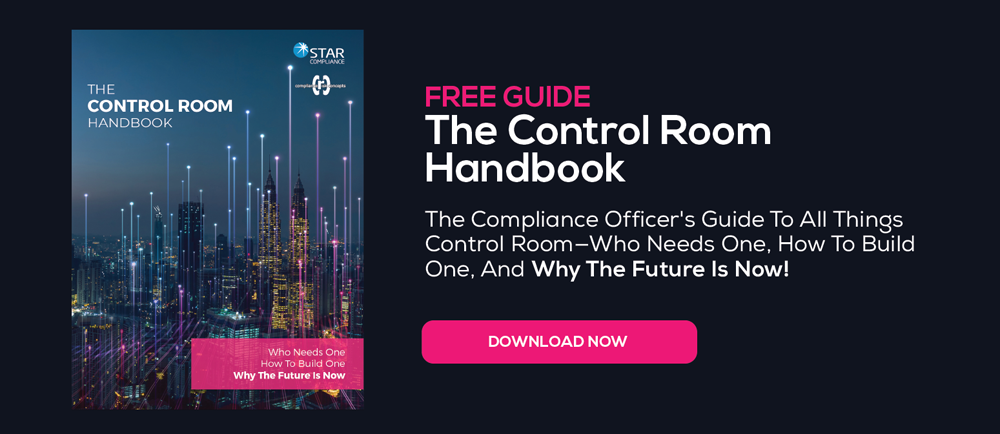Compliance control room officers' duties have expanded over time. Should your firm level up its control room game with compliance automation software?
Firms that have both private and public sides have been familiar with control rooms for a long time. Complex deals on the private side generate a lot of sensitive information that must be closely monitored to prevent conflicts of interest: which can mean missed revenue opportunities and regulatory trouble. And for three decades, control room officers have served as the traffic cops for all of this fast-moving, sensitive information.
It all began in 1988, after a decade of insider trading and securities-fraud cases prompted the passage of the Insider Trading and Securities Fraud Enforcement Act, or ITSFEA, which created new expectations and requirements for broker-dealers. The act mandated that firms develop policies and procedures to detect and prevent the misuse of material nonpublic information, or MNPI. The National Association of Securities Dealers, now FINRA, expanded on this in 1991 by laying out the minimum requirements of adequate information barrier policies and procedures.
On the basis of that guidance, control rooms started popping up in firms by 1992. In the decades that followed, however, the duties of control room officers have greatly expanded, and some firms are struggling to keep up.
THE EVOLUTION OF CONTROL ROOM MANAGEMENT
These early control rooms were just like they sound: physical rooms akin to air traffic control towers, where compliance professionals used tools like spreadsheets and email chains to track the flow of MNPI, sort through potential conflicts, keep track of deal team members, and integrate new regulations and guidance.
Control room departments today do the same things, just at a much higher volume. As firms grow and do more deals, the quantity of deal-related information grows, too. With so much more information to organize, record, and analyze, control rooms can’t rely on decades-old tech like spreadsheets and emails to keep their firms safe and ensure that each deal goes through without a hitch.
Control rooms today need the right compliance automation software to keep up in an increasingly complex environment. The right compliance software will integrate with existing firm systems—such as CRM, HR, market data, and research—to funnel deal-related data through one central platform. This will greatly simplify deal-data analysis and help control rooms more quickly and accurately determine where potential conflicts might lie. In short, the right control room software can help control room teams lower firm risk and make faster, smarter decisions.
LEVEL UP WITH COMPLIANCE AUTOMATION SOFTWARE
If your firm is growing and expanding the scope of its activity—building relationships with private equity, offering wealth or asset management services, assisting with M&A advisory or acquisition financing, or any number of other activities that add to the amount of sensitive information coursing through your firm—it’s time to examine how well-positioned your compliance capabilities are to handle the influx of activity and information.
If you don’t have a control room equipped with compliance automation software yet, you’ll soon need it, as the deal landscape continues to grow more complex and bring in even more information in the following ways:
1. AS FIRMS EXPAND, DEALS INCREASE IN NUMBER, SIZE, AND COMPLEXITY
Looking just at M&A deals, a recent PwC survey found that 53% of U.S. executives said their companies plan to increase M&A investments in 2021. As firms expand into M&A, trading, research, sales, and more activities that generate privileged information, they accumulate more and more MNPI. With firms generating more information as deal volumes rise and deal sizes increase, it becomes increasingly difficult for control room teams to wrap their hands around all potential conflicts. As their ability to accurately and efficiently vet deals diminishes in the face of proliferating information, firm risk grows. Without the aid of compliance automation software, it’s simply unrealistic to expect them to have eyes and ears on every angle of every deal.
2. AS FIRMS EXPAND, THEY ALSO DIVERSIFY AND OFFER MORE SERVICES
And these new and expanded service offerings can create a whole new range of potential conflicts of interest to be monitored and managed. For example, most large financial firms, no matter what they specialize in, write proprietary research about companies. Firms generate revenue by selling advice and guidance based on this research to clients. At the same time, another department within the same large financial firm is helping the same company raise capital and is generating fees from providing that service. Activities between the research division and the investment banking division thus need to be monitored to ensure there are no conflicts of interest.
From there, compliance must ensure that sound information barriers, a.k.a., walls, are put in place and closely monitored and managed so that information from all these competing internal departments stays where it’s supposed to stay, or moves only between the departments and people it’s supposed to move between. Compliance tech—and the automation, centralization, and streamlining it brings—is what makes tackling all of these increasingly complex information-monitoring challenges possible.
3. FINANCIAL SERVICES TEAMS ARE MORE SPREAD OUT
Financial services workers, as are knowledge workers in so many fields, more dispersed geographically right now. The pandemic sent many finance workers into remote-work environments in the early months of 2020, and most are still working remotely today. To solve the communications challenges that arose when teams went remote, companies adopted additional digital collaboration tools to stay connected. Apps like Slack and Zoom are now regular channels through which people communicate and transmit deal-related information.
The people employees live and share space with is also cause for concern. In an office space, departments are separated by floors to provide a stopgap for the purposeful—or accidental—sharing of MNPI, but that kind of oversight is nonexistent at home. For control rooms, all of this means the flow of MNPI has grown even more complex and difficult to track.
4. REGULATION IS ON THE RISE GLOBALLY
As firms expand their activity and deals become more complicated, regulations are also evolving. And just like the rest of the industry they’re only becoming more complex. There are also more of them. In 2018 alone, 982 different regulatory bodies issued 57,364 new alerts. As technology continues to become an indispensable part of this sector, regulators are turning to big data to keep firms under even closer scrutiny. With this increased oversight, compliance teams need tech-enabled surveillance capabilities to ensure they’re catching and identifying conflicts or suspicious trade activity before regulators do. As firms continue to grow and accumulate more MNPI and other deal-related data, the job of the control room officer will only grow more complex and more critical to the success of the firm. Fortunately, the right compliance automation software is out there, and it can help your firm avoid regulatory and reputational risk, and succeed now and into the future. 


